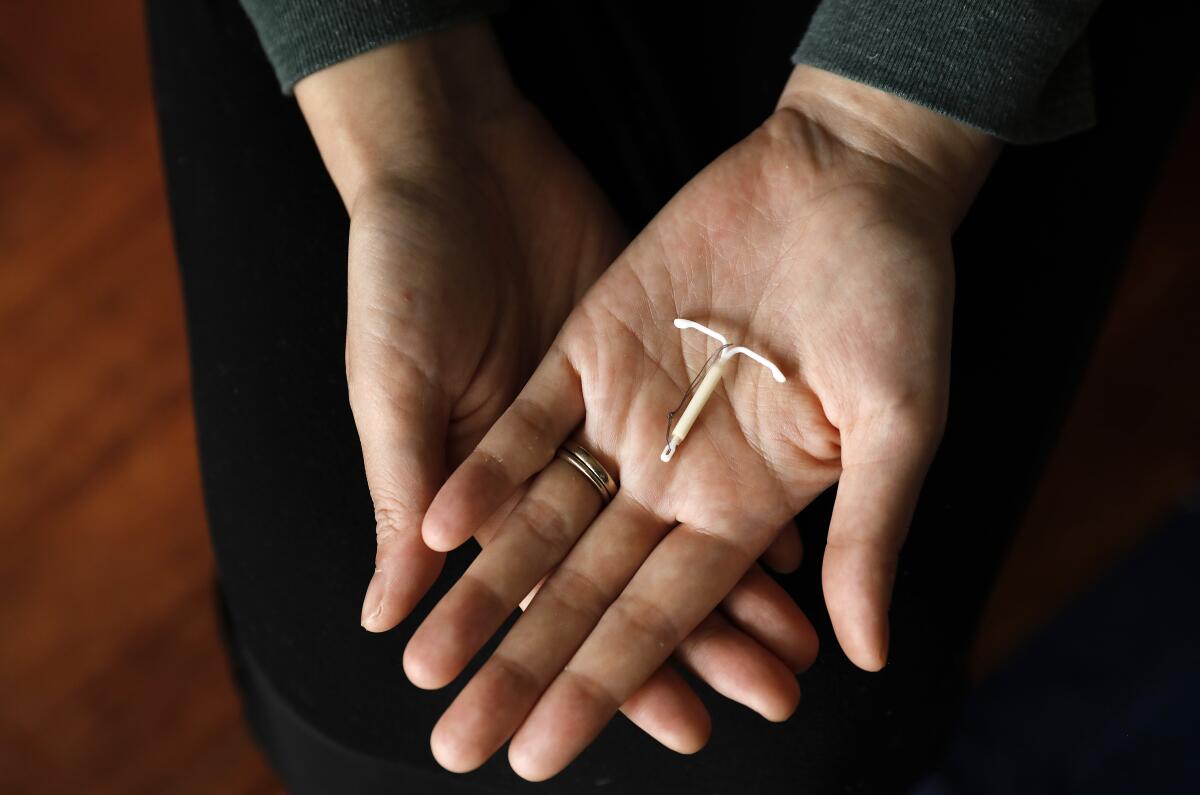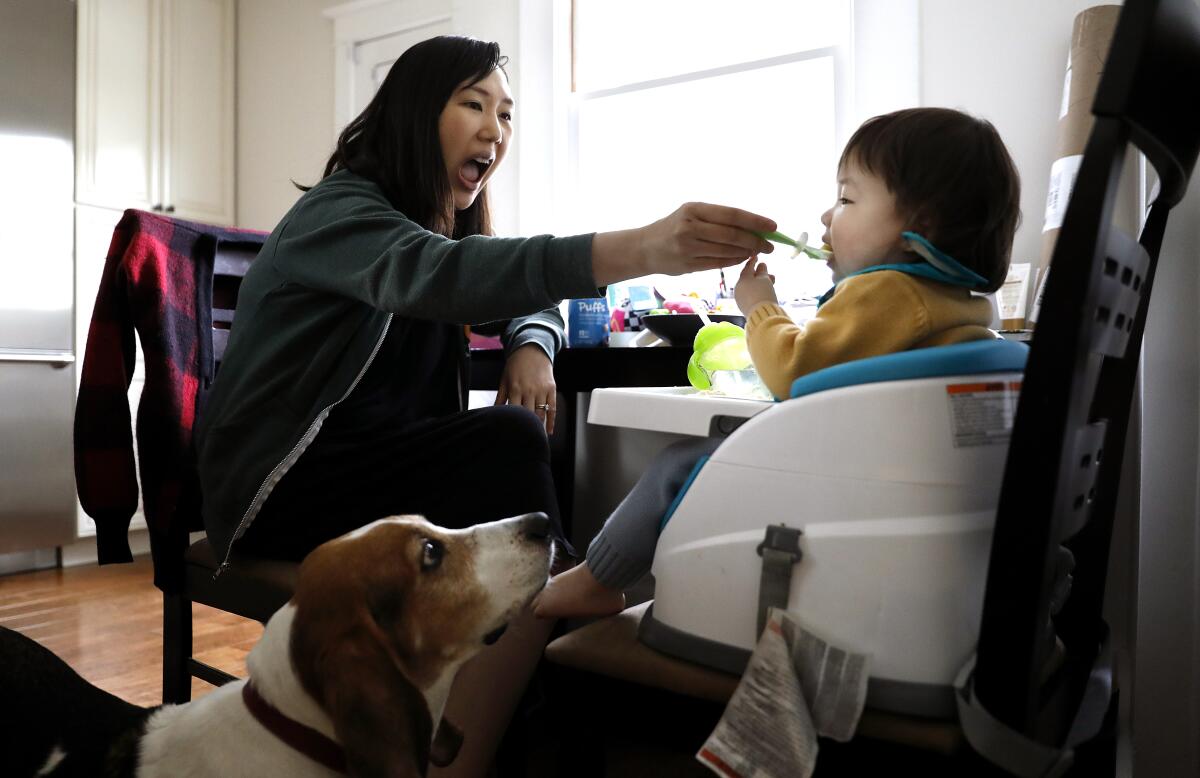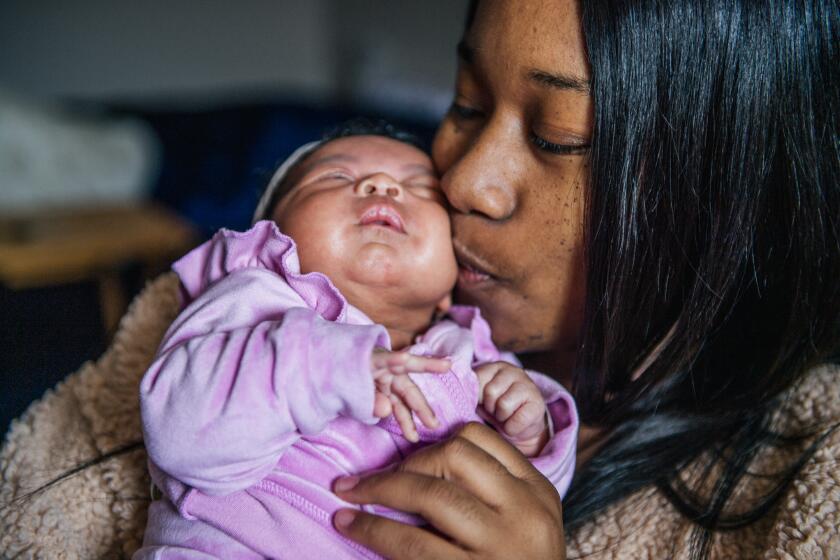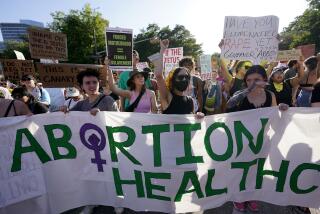California is seeing a COVID-19 baby bust. What is causing it?

California is poised to drop its mask mandate for a vaccine-fueled summer of lust — but when it comes to protection, Angelenos like Jahkara Smith won’t rely on antibodies alone.
“A lot of my friends have gotten IUDs recently,” said the 24-year-old Air Force veteran, a YouTube icon turned TV star. “Even if you lose your healthcare, it’s already in there. They’re not going to come take it out.”
The humble IUD, shorthand for intrauterine device, is just one of many reasons California is expected to see almost 50,000 fewer births in 2021, the nadir of a national COVID-19 “baby bust” that has sparked political backlash and left young families and would-be parents drowning in demographic quicksand. While Californians put off pregnancy in many other ways — among them prescription-free pills, self-injected hormones, and higher rates of abstinence and abortion — experts say the tiny T-shaped device helped an unprecedented number ghost the stork in recent months.
California saw a net gain of only 21,200 residents in the year that ended July 1, a paltry 0.05% growth rate not seen since 1900, a new report reveals.
“Because I have my IUD, I have time to plan,” Smith said. “A lot of my friends talk about wanting babies — I want babies — but when you think about the tools that you’re given versus the tools you need, it feels really grim.”
Economists, demographers and reproductive health experts agree: The COVID-19 crisis capped a decade in which basic costs far outpaced wages, at the same time that the Affordable Care Act made birth control effectively free for most Americans. This is especially true in California, where fair market rent runs as much as a Tesla, preschool costs the same as UC Berkeley, and an IUD averages $0 with both public and private insurance.
“People imagine some ‘Children of Men’ situation, when in reality the pandemic freaked people out,” said Ponta Abadi, a reproductive health expert, referring to the 2006 apocalyptic thriller in which a pandemic leaves humanity infertile. “It caused a lot of people to lose their jobs and affected whether they wanted to have kids.”
Historical data bear this out, said Melissa Kearney, a professor of economics at the University of Maryland. The Spanish flu pandemic of 1918 led to a significant baby bust despite the fact that contraception was both rudimentary and almost totally illegal at the time. During the Great Recession, the birth rate declined about 1% for every percent unemployment rose.
New survey data from the Guttmacher Institute, a think tank that advocates for reproductive rights, suggest this time around the effect could be even greater. More than a third of respondents said they planned to either put off having children or have fewer because of the pandemic, which was devastating to reproductive-age women despite being far more deadly to older men. Roughly half of the 5 million women who were thrown out of work last spring had young children, and another million mothers were pushed out by the pressure of remote school in the fall and winter. Others delayed or ended pregnancies amid news that COVID-19 could be more severe and more fatal in pregnant people.
The impact was seismic: Local abortion providers were already seeing a spike in demand as early as April 2020, and clinicians across the country said they have since helped front-line healthcare workers, newly unemployed parents and working mothers-turned-teachers terminate pregnancies that, in any other year, would have ended in the delivery room.
“When things switched to virtual schools, we had to overhaul our schedule completely,” said Dr. Diane Horvath, an abortion provider in Maryland. “[Many] people told us that had we not been in the pandemic, they would have continued the pregnancy.”
But abortion remains at near historic lows, and there’s little evidence it was greater in California than in other states. Nor are millennials in the Golden State meaningfully different in educational attainment or family structures from their peers in other populous states where the decline has been more modest. Instead, experts say, a sharper spike in pandemic unemployment here put strong downward pressure on parents and would-be parents who were already strained under stagnant wages, rising rent and other economic strains that have been depressing birth rates for years.
Those pressures are especially acute in Los Angeles, where rents have increased at almost double the rate of wages in the last 10 years. Sending a preschooler to a home day-care facility now costs significantly more than sending a freshman to Cal State Long Beach; infant care exceeds undergraduate tuition at UCLA, where fees have gone up by 30% this past decade. Yet only 1 in every 4 children whose parents can afford day care in Los Angeles finds a spot. For those who rely on state subsidies, that number is 1 in 9.
“[Child care] is not just unaffordable, it’s unavailable,” said Jessica Chang, chief executive of WeeCare, the country’s largest home day-care network. “It’s a big factor for why people [here] have fewer children.”
Child care is now more expensive than housing in California, and housing is more expensive here than in any state except Hawaii.
“Housing prices took off after 2014, and that weighed heavily on people,” said Dowell Myers, a professor of urban planning and demography at USC.
That also happens to be the year IUDs emerged as one of the most popular forms of birth control in America, after decades languishing in the shadow of a failed early model that was pulled from the market before most modern users were conceived.

“IUDs are super popular with younger folks,” who’ve only ever known safe, free models, Abadi said.
In 2007, the last high watermark for American fertility, about 6% of women who were trying to prevent pregnancy used long-acting, reversible contraceptives like IUDs — already a significant jump from 2000, when about 2% did. By 2014, just three years after they became free for most patients under Obamacare, that number was close to 15%. And when access was threatened in the wake of the 2016 election, insertions surged again.
This is where the long in long-acting reversible contraceptives becomes important. A copper IUD like Smith’s can prevent pregnancy for up to 12 years — roughly a third of the average woman’s reproductive lifespan. Yet, just 12 years ago, before the Affordable Care Act, most doctors would not prescribe them to women who hadn’t had children, and getting one inserted could cost more than a first-trimester abortion. Three of the four hormonal IUDs currently on the market — and inside millions of Americans — still hadn’t been approved by the Food and Drug Administration.
That makes them more attractive to many women, since access to birth control is still limited by politics and insurance coverage even under the law.
“I got an IUD the day before my 26th birthday, when I was still covered under my parents’ insurance,” said novelist Steph Cha, who relied on hers for seven years. “When I got my IUD removed, I asked the doctor if I could take it home. I have it in my wallet — it’s a little talisman.”
Like Smith, Cha said the device let her and her husband establish themselves professionally before starting a family.
“We always wanted kids, we just put it off,” she said as she fed the couple’s 13-month-old son Leo in their Mid-City home on a recent morning. “Now seemed like a good time.”

Ironically, Cha gave birth to Leo just weeks into California’s stay-at-home order in April 2020. She was among the first Angelenos to go through labor in a face mask, amid tight new restrictions on who could attend the delivery. At the time, mothers who tested positive for the coronavirus in the hospital were being forcibly separated from their newborns, and the rare inflammatory syndrome that affects children had just been identified.
It’s clear now how terrifying those conditions were to California families. In December, when babies conceived in mid-March through early April would be expected to be born, the state saw a 10% drop-off in deliveries, compared with the 2% year-over-year decline that had been typical for about the last decade. In January, when most babies conceived in April and early May would be born, births fell a staggering 23%.
“There was so much fear and confusion — ‘What if I get pregnant, what is the effect of the infection on pregnancy?’” said Dr. Aparna Sridhar, a professor of obstetrics and gynecology at UCLA. “When the pandemic was really at its peak, we were also offering pregnant women post-placental IUDs,” where the device is inserted by hand just minutes after a baby is delivered. “We were trying to prevent them from having to come back in.”
Yet, in many ways, the pandemic has been an ideal time for Cha as a new mother.
“Having both parents working at home for a whole year, I feel like we’ve weirdly benefited,” she explained while Leo toddled around Montessori-style wooden toys. “If you are the kind of person who has ... resources, now is probably a great time to do it. Whereas if you don’t know what your job situation is, or how much you’re going to have to spend on healthcare in the next year, it’s a terrible time to get pregnant.”
For reproductive healthcare workers, individuals’ ability to have children when they want to and not have them when they don’t is the ultimate goal. But tens of thousands more individuals deciding not to get pregnant at the same time worries economists and demographers, who say it could put enormous pressure on the economy in years to come.
Some believe the American Families Plan announced in April and the universal transitional kindergarten program put forward this month by Gov. Gavin Newsom will help give pregnancy back its glow. But others worry it won’t be enough to offset sharp declines in immigration — the state’s main source of population growth for years — or the ongoing economic pressures that make childbearing untenable for so many young people.
“I wish we would have bigger discussions about what’s causing people’s anxieties, outside of the pandemic,” Abadi said. “People maybe just don’t want to have kids right now ‘cause it sucks.”
More to Read
Start your day right
Sign up for Essential California for news, features and recommendations from the L.A. Times and beyond in your inbox six days a week.
You may occasionally receive promotional content from the Los Angeles Times.








